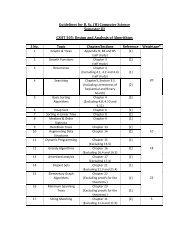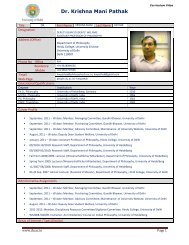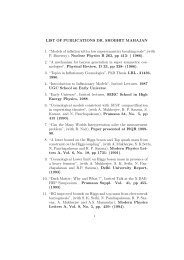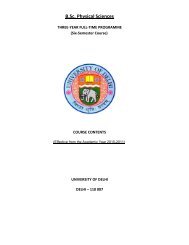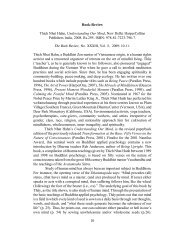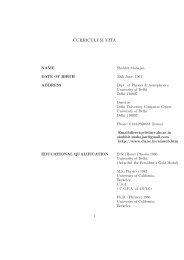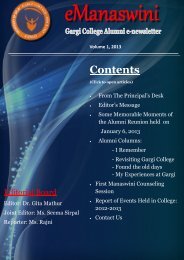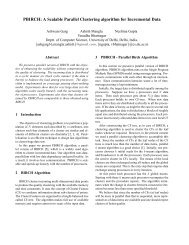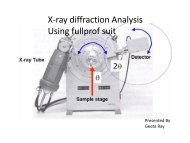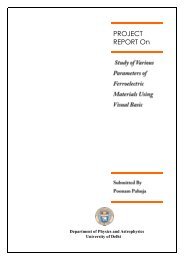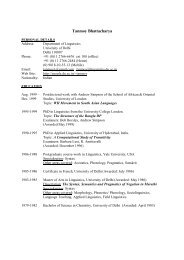Handout-3 - Home Pages of People@DU - University of Delhi
Handout-3 - Home Pages of People@DU - University of Delhi
Handout-3 - Home Pages of People@DU - University of Delhi
You also want an ePaper? Increase the reach of your titles
YUMPU automatically turns print PDFs into web optimized ePapers that Google loves.
Pradeep Kumar Das, Department <strong>of</strong> Linguistics, <strong>University</strong> <strong>of</strong> <strong>Delhi</strong>, <strong>Delhi</strong>-7<br />
Centre <strong>of</strong> Linguistics and English<br />
CLLS&CS, JNU, New <strong>Delhi</strong><br />
110007<br />
Morphology<br />
Morphology (Class <strong>Handout</strong>)<br />
What could be the morphology <strong>of</strong> the word ‘morphology’ Well, if you rely on or<br />
believe in the Latin source or notion <strong>of</strong> Latinate root (i.e. a notion that will be explained to you<br />
later in the course), you could say that the morphology <strong>of</strong> “Morphology” is “morph”-<br />
‘form/shape’ and “ology”- ‘study’ or ‘branch <strong>of</strong> knowledge’. So, we can say that “Morphology”<br />
is the study <strong>of</strong> shape/form <strong>of</strong> words.<br />
It is natural if one wonders, ‘A word is a ‘WORD’. What is so special about its shape or form’<br />
The reaction is justified as we are not used to wonder at such small things. However, as a<br />
student/teacher/member <strong>of</strong> the discipline (i.e. Linguistics), we cannot simply be satisfied when<br />
we look at the following words and don’t inquire about the nature <strong>of</strong> their structure or at least<br />
shape:<br />
Words letters syllables<br />
a 01 01<br />
on 02 01<br />
the 03 01<br />
poor 04 01<br />
clear 05 01<br />
centre 06 02<br />
central 07 02<br />
centralize 10 03<br />
centralization 14 05<br />
The given details <strong>of</strong> these words are not<br />
directly related to the form or shape <strong>of</strong> the<br />
words that we study in Morphology;<br />
however, the details justify the motivation<br />
<strong>of</strong> the discipline ‘Morphology’. If there are<br />
some accountable differences amongst<br />
these words, let it be <strong>of</strong> orthographic or<br />
syllabic, it is not wise to call them just<br />
WORDS, and more so, the same kinds or<br />
types <strong>of</strong> words.<br />
We started the course with a simple division/distinction <strong>of</strong> WORDS in mainly two and<br />
then extended them into three categories. Let us start with the basic two categories we discussed<br />
in the class.<br />
1
\\<br />
Pradeep Kumar Das, Department <strong>of</strong> Linguistics, <strong>University</strong> <strong>of</strong> <strong>Delhi</strong>, <strong>Delhi</strong>-7<br />
simple<br />
an, in, the, <strong>of</strong>, and,<br />
party, south, Africa,<br />
when, a, unity,<br />
new, interim,<br />
into, practice,<br />
led, after, few,<br />
final, on, this,<br />
February, other,<br />
every, by, bill<br />
etc…<br />
complex<br />
<strong>of</strong>ficial, racial,<br />
national, instigated<br />
became, provisional<br />
majority, negotiated<br />
government, came<br />
provinces, cultural<br />
recognition, leaders<br />
traditional, amongst<br />
democratic, things<br />
etc..<br />
WORD<br />
Simple<br />
(and, this, boy) Complex<br />
Compound<br />
Complex<br />
(two-third, forty-six )<br />
(boys, <strong>of</strong>ficial, became)<br />
After the first step into the world <strong>of</strong> awareness, it was quite fascinating for us to realize<br />
that WORDS are not that simple as they look. We should start internalizing the ideas that there<br />
are WORDS and there are WORD-PARTS. Words like ‘and’, ‘this’ & ‘boy’ are called simple<br />
words because they are only WORDS i.e. they don’t contain any WORD-PART that can be<br />
taken out from them and still have them as meaningful words. The words ‘<strong>of</strong>fice + al’, ‘boy + s’<br />
& ‘become + past’ not only contain WORD but also have WORD-PARTS which make these<br />
words complex words. This is so, because even if we take out these WORD-PARTS out <strong>of</strong><br />
these words, they don’t loose the status <strong>of</strong> WORDS. (NOTE: Compound words will be<br />
explained in the course later).<br />
It is an interesting as well as eye-opening fact to acknowledge that ‘boy’ is a simple<br />
word, however, if we add a WORD-PART ‘-s ’ to the word ‘boy’, it becomes a complex word.<br />
So, there must be something important about this ‘-s’ in morphology. Does it have a meaning <strong>of</strong><br />
its own If you think carefully, you will agree to the fact that it does have a meaning. What is<br />
that meaning Well, simple enough, it makes a singular word (i.e. a Noun) into a plural word.<br />
What else Does it have some other meaning too THINK about it. We will learn about it bit<br />
later in the course.<br />
When we talk about the WORD-PART ‘-s’ and try to decide the nature and<br />
meaning <strong>of</strong> the word-part, we are not talking about the orthographic<br />
representation <strong>of</strong> ‘-s’ i.e. it is not ‘-es’ ‘esa<br />
esa’ . We are talking about the pronunciation<br />
<strong>of</strong> the WORD-PART which is just ‘-s’ ‘sa<br />
sa\<br />
\’ sound. It is necessary to make this<br />
distinction at this stage because our argumentation and analysis will heavily rely<br />
on this distinction.<br />
2
Pradeep Kumar Das, Department <strong>of</strong> Linguistics, <strong>University</strong> <strong>of</strong> <strong>Delhi</strong>, <strong>Delhi</strong>-7<br />
We asked a question about the other possible meaning <strong>of</strong> the WORD-PART ‘-s’ in the<br />
earlier paragraph. Once again if you observe the words in the given TEXT or any text for that<br />
matter you will agree that we also find other uses <strong>of</strong> the WORD-PART ‘-s’ in English.<br />
For example: He talks too much. She runs very fast. The boy brushes his teeth<br />
thrice a day.<br />
Here is our earlier use <strong>of</strong> the WORD-PART ‘-s’, we have talked so much about:<br />
For example: I bought two books yesterday. She has three dogs at home. We<br />
should be careful about the buses.<br />
We have to make a careful distinction <strong>of</strong> these two types <strong>of</strong> WORD-PARTS in our<br />
examples. There is nothing very new to talk about these WORD-PARTS. We all have learned<br />
this much in our school grammar. In the first use <strong>of</strong> this word-part when it gets attached to a<br />
NOUN (Singular), it turns that NOUN into a plural counterpart while in the latter use <strong>of</strong> the<br />
WORD-PART where it occurs with a VERB, it requires the verb to be in simple present form<br />
and can only take a SUBJECT that is 3 rd Person Singular. For example:<br />
BOOK( NSg ) ! BOOKS ( NPl )<br />
DOG ( NSg ) ! DOGS ( NPl )<br />
BUS ( NSg ) ! BUSES ( NPl )<br />
He TALKS {pres, 3rdPSg} a lot.<br />
She RUNS {pres, 3rdPSg} very fast.<br />
The boy BRUSHES {pres, 3rdPSg} his teeth thrice a day.<br />
So, there are at least two different uses <strong>of</strong> the WORD-PART ‘-s’ in English, we talked<br />
about in the course. Nevertheless, there is another use <strong>of</strong> this WORD-PART in English that has<br />
somewhat a different orthographic representation. We are bringing this example in the<br />
discussion deliberately to remind you again that we pay much more attention to the<br />
pronunciation (sound) part <strong>of</strong> the WORDS in linguistics than the written form. The other use <strong>of</strong><br />
the WORD-PART ‘-s’ in English is as the possessive marker written with an apostrophe e.g.<br />
“-’s”. Here is the example:<br />
3
Pradeep Kumar Das, Department <strong>of</strong> Linguistics, <strong>University</strong> <strong>of</strong> <strong>Delhi</strong>, <strong>Delhi</strong>-7<br />
The book’s cover…<br />
Bill’s book…<br />
Rich’s bike… (Rich is the short<br />
form <strong>of</strong> a proper name Richard)<br />
What should we say about the three different uses <strong>of</strong> the WORD-PART ‘-s’ in English<br />
Well, there is a term used in Semantics (i.e. the branch <strong>of</strong> linguistics that studies the MEANING<br />
<strong>of</strong> words, phrases and sentences), called HOMOPHONY. The homophonous words are those<br />
words that have SAME FORM but different meaning. Same FORM here means the<br />
pronunciation part. Let us see our three WORD-PARTS in this context:<br />
1. ‘-s’ 2. ‘-s’ 3. “-’s ”<br />
N [Pl] V {3rdPSg, Pres} [Possessive marker]<br />
‘-s’<br />
We think we have made it clear enough to you by now that there is a meaning <strong>of</strong> the<br />
WORD-PART ‘-s’. But does it also mean that this WORD-PART ‘S’ has its meaning anywhere<br />
it occurs THINK about it.<br />
Look at the following words discussed in the class:<br />
S=1,2,4<br />
does not<br />
have any<br />
meaning<br />
S 1 ip<br />
S 2 ips 3(n)<br />
S 4 ips 5(v)<br />
S 3 =is a Plural marker<br />
S 5 = tells us that:<br />
V {3rdPSg, Pres}<br />
4
Pradeep Kumar Das, Department <strong>of</strong> Linguistics, <strong>University</strong> <strong>of</strong> <strong>Delhi</strong>, <strong>Delhi</strong>-7<br />
So, the point is that not every occurrence <strong>of</strong> [ S ] has its own meaning and the meaning <strong>of</strong><br />
the WORD-PART ‘-s’ is contextually bound. What is the common factor amongst its<br />
occurrences in most <strong>of</strong> the cases It is very simple and predictable from the uses that the<br />
WORD-PART has its own meaning and when it gets attached to simple word, the word in result<br />
turns into a complex one.<br />
We think, this adequately explains the nature <strong>of</strong> the WORD-PART ‘-s’. We should also<br />
make it clear at this stage that the nature <strong>of</strong> the WORD-PART, whether it is ‘-s’, ‘-al’ or ‘-ity’,<br />
all <strong>of</strong> them need such attention and elaboration.<br />
Let us bring back our initial discussion and see what we can now say about the WORDS<br />
we started the whole debate with!<br />
Words<br />
1. a<br />
2. on<br />
3. the<br />
4. poor<br />
5. clear<br />
6. centre<br />
7. central<br />
8. centralize<br />
9. centralization<br />
Wouldn’t it be foolish to ask how many words are there in the list (especially when we<br />
have numbered all <strong>of</strong> them) What do you say We should think about the question again and<br />
again. Had we been talking about the WORD in layman’s term, we wouldn’t have come here to<br />
study or teach ‘Morphology’. So, in order to maintain the distinction amongst different kinds <strong>of</strong><br />
WORDS, we have a term in ‘morphology’ called ‘MORPHEME’. The definition <strong>of</strong> a<br />
‘morpheme’ is as follows:<br />
A morpheme is the smallest indivisible meaningful unit <strong>of</strong> language.<br />
5
Pradeep Kumar Das, Department <strong>of</strong> Linguistics, <strong>University</strong> <strong>of</strong> <strong>Delhi</strong>, <strong>Delhi</strong>-7<br />
The term ‘morpheme’ is new but the function that the aforementioned definition assigns<br />
to it makes it somewhat familiar to what we have been calling WORD & WORD-PART up to<br />
now. So, if we ask a simple question as to what is the WORD and what is the WORD-PART in<br />
‘Boys’ and ‘Books’, you will all agree that ‘boy’ and ‘book’ are WORDS while ‘-s’ in both<br />
cases is the WORD-PART. If we replace the TERM ‘word-part’ with ‘morpheme’ and ask how<br />
many ‘morphemes’ are there in the given two words, there should be no problem in saying that<br />
there are TWO morphemes in each words. Similarly, if we say there are 15 ‘morphemes’ in the<br />
list <strong>of</strong> 9 words, will you agree to it or not If you say ‘yes’, justify your answer, and if you say<br />
‘no’, explain why.<br />
Let us now turn to the shape <strong>of</strong> the ‘morpheme’ ‘-s’ in the given examples:<br />
NOUNS VERBS Possessive marker<br />
Written form Pronunciation Written form Pronunciation Written form Pronunciation<br />
books /-s/ talks /-s/ book’s cover /-s/<br />
dogs /-z/ turns /-z/ Bill’s book /-z/<br />
buses /-iz/ brushes /-iz/ Rich’s bike /iz/<br />
We can summarize the facts <strong>of</strong> the tables in the following ways:<br />
/-S/<br />
/-s/ /-z/ /-iz/<br />
when the morpheme when the morpheme when the morpheme is<br />
is added to a word that is added to a word that added to a word that<br />
ends in a voiceless sound. ends in a voiced sound. ends in a sibilant sound<br />
We need to introduce another term here to describe such function <strong>of</strong> a ‘morpheme’. A<br />
morpheme which has different shapes/form but one meaning is called an ALLOMORPH.<br />
Examine the following words (verbs) and pay attention to the past tense morpheme ‘-ed’ and its<br />
different pronunciations depending on the environment in which the morpheme ‘-ed’ occurs:<br />
6
Pradeep Kumar Das, Department <strong>of</strong> Linguistics, <strong>University</strong> <strong>of</strong> <strong>Delhi</strong>, <strong>Delhi</strong>-7<br />
Verb Written form pronunciation Explanation:<br />
paint paint-ed /-id/ The past tense morpheme ‘-ed’ is pronounced as /-id/ if it occurs<br />
mend mend-ed /-id/ before a word that ends in either / t / or / d / sound.<br />
-----------------------------------------------------------------------------------------------------------------------------------------------<br />
turn turn-ed /-d/ The past tense morpheme ‘-ed’ is pronounced as / -d/ if it occurs<br />
force force-d /-d/ before a word that ends in a voiced sound except a sound /-d/.<br />
-----------------------------------------------------------------------------------------------------------------------------------------------<br />
park park-ed /-t/ The past tense morpheme ‘-ed’ is pronounced as /-t/ if it occurs<br />
pick pick-ed /-t / before a word that ends in a voiceless sound except a sound / t/.<br />
So, we can say that the past tense morpheme ‘-ed’ also a morpheme that has three<br />
different forms/shapes as given in the diagram above. These three different forms/shapes <strong>of</strong> the<br />
past tense morpheme are also called the allomorphs <strong>of</strong> the /-ed/. We can draw a diagram similar<br />
to the morpheme ‘-s’ as follows:<br />
/-ed/<br />
/-t/ /-d/ /-id/<br />
if the word ends in if the word ends in if the word ends either<br />
a voiceless sound a voiced sound except in a / t/ or a / d/ sound<br />
except / t/<br />
/ d/<br />
7



